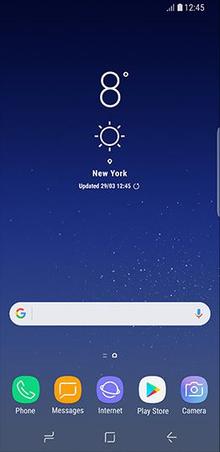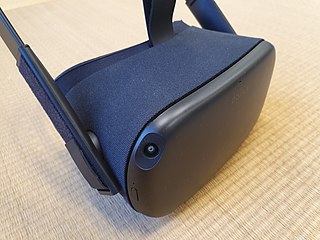
Oculus Rift is a discontinued line of virtual reality headsets developed and manufactured by Oculus VR, a virtual reality company founded by Palmer Luckey that is widely credited with reviving the virtual reality industry. It was the first virtual reality headset to provide a realistic experience at an accessible price, utilizing novel technology to increase quality and reduce cost by orders of magnitude compared to earlier systems. The first headset in the line was the Oculus Rift DK1, released on March 28, 2013. The last was the Oculus Rift S, discontinued in April 2021.

The Samsung Galaxy Note 4 is an Android smartphone developed and produced by Samsung Electronics. It was unveiled during a Samsung press conference at IFA Berlin on 3 September 2014 and was released globally in October 2014 as successor to the Samsung Galaxy Note 3. Improvements include expanded stylus-related functionality, an optically stabilized rear camera, 1440p quad-HD filming on the front camera, significantly increased charging rate, revised multi-windowing, and fingerprint unlocking. It is the last in the Galaxy Note series with interchangeable battery. Its subsequent model, the Galaxy Note 5, was unveiled on 13 August 2015.

Reality Labs, formerly Oculus VR, is a business and research unit of Meta Platforms that produces virtual reality (VR) and augmented reality (AR) hardware and software, including virtual reality headsets such as the Quest, and online platforms such as Horizon Worlds. In June 2022, several artificial intelligence (AI) initiatives that were previously a part of Meta AI were transitioned to Reality Labs. This also includes Meta's fundamental AI Research laboratory FAIR which is now part of the Reality Labs - Research (RLR) division.

Google Cardboard is a discontinued virtual reality (VR) platform developed by Google. Named for its fold-out cardboard viewer into which a smartphone is inserted, the platform was intended as a low-cost system to encourage interest and development in VR applications. Users can either build their own viewer from simple, low-cost components using specifications published by Google, or purchase a pre-manufactured one. To use the platform, users run Cardboard-compatible mobile apps on their phone, place it into the back of the viewer, and view content through the lenses.

The Samsung Galaxy S6 is a line of Android-based smartphones manufactured, released and marketed by Samsung Electronics. Succeeding the Samsung Galaxy S5, the S6 was not released as a singular model, but instead in two variations unveiled and marketed together—the Galaxy S6 and Galaxy S6 Edge—with the latter differentiated primarily by having a display that is wrapped along the sides of the device. It is distinguished from its predecessor through a internal battery with an increased charging speed but a decreased capacity, an optically stabilized camera, sound in slow motion video recordings, a glass back, and it lacks a user-replaceable battery, a memory card slot, water resistance, and MHL-to-HDMI connection for viewing on an external monitor or television set.
WebXR Device API is a Web application programming interface (API) that describes support for accessing augmented reality and virtual reality devices, such as the HTC Vive, Oculus Rift, Meta Quest, Google Cardboard, HoloLens, Apple Vision Pro, Magic Leap or Open Source Virtual Reality (OSVR), in a web browser. The WebXR Device API and related APIs are standards defined by W3C groups, the Immersive Web Community Group and Immersive Web Working Group. While the Community Group works on the proposals in the incubation period, the Working Group defines the final web specifications to be implemented by the browsers.

Kubity is a cloud-based 3D communication tool that works on desktop computers, the web, smartphones, tablets, augmented reality gear, and virtual reality glasses. Kubity is powered by several proprietary 3D processing engines including "Paragone" and "Etna" that prepare the 3D file for transfer over mobile devices.

The Samsung Galaxy S7, Samsung Galaxy S7 Edge and Samsung Galaxy S7 Active are Android-based smartphones manufactured, released and marketed by Samsung Electronics. The S7 series serves as the successor to the Galaxy S6, S6 Edge, S6 Edge+ and S6 Active released in 2015. The S7 and S7 Edge were officially unveiled on 21 February 2016 during a Samsung press conference at Mobile World Congress, with a European and North American release on 11 March 2016. The S7 Active was unveiled on 4 June 2016, and released on AT&T in the United States on 10 June 2016.

A virtual reality headset is a head-mounted device that uses 3D near-eye displays and positional tracking to provide a virtual reality environment for the user. VR headsets are widely used with VR video games, but they are also used in other applications, including simulators and trainers. VR headsets typically include a stereoscopic display, stereo sound, and sensors like accelerometers and gyroscopes for tracking the pose of the user's head to match the orientation of the virtual camera with the user's eye positions in the real world. AR headsets are similar to VR headsets, but AR headsets enable the user to see and interact with the outside world. Examples of AR headsets include the Apple Vision Pro and Meta Quest 3.
Virtual Desktop is remote control software for Android-based virtual reality headsets. It allows users to control a PC over a wireless LAN from the headset, including the ability to stream VR games and software.

The Samsung Galaxy Note 7 is a recalled and discontinued Android-based phablet developed, produced and marketed by Samsung Electronics. Unveiled on 2 August 2016, it was officially released on 19 August 2016 as a successor to the Galaxy Note 5. It is Samsung's first phone with a USB-C connector, and the last phone in the Galaxy Note series to have a physical home button. Although it is the sixth main device in the Galaxy Note series, Samsung branded its series number as "7" instead of "6" so consumers would not perceive it as being inferior to the flagship Samsung Galaxy S7, and to prevent confusion about the order of release due to the same release year (2016).

Daydream is a discontinued virtual reality (VR) platform which was developed by Google, primarily for use with a headset into which a smartphone is inserted. It is available for select phones running the Android mobile operating system that meet the platform's software and hardware requirements. Daydream was announced at the Google I/O developer conference in May 2016, and the first headset, the Daydream View, was released on November 10, 2016. To use the platform, users place their phone into the back of a headset, run Daydream-compatible mobile apps, and view content through the viewer's lenses.

The Samsung Gear 360 is the first 360 degree camera by Samsung Electronics. It was released as a part of the Samsung Gear family of devices. It uses two cameras to take 360° photos and videos.

Alcatel Idol 4 and Idol 4S are smartphones manufactured by TCL Corporation and marketed by Alcatel Mobile Phones. They were unveiled during Mobile World Congress in February 2016, and are a successor to the Idol 3. The Idol 4 and 4S are positioned as mid-range devices, with the 4S serving as a higher-end model with a faster processor, a larger 1440p display, and a bundled virtual reality headset which serves as the device's packaging.

Samsung Experience was the name of the software overlay by Samsung for its Galaxy devices running Android 7.x “Nougat” and Android 8.x “Oreo”. It was introduced in late 2016 on a beta build based on Android 7.0 “Nougat” for the Galaxy S7, succeeding TouchWiz. It has been succeeded in 2018 by One UI based on Android 9 “Pie” and later versions.
OpenXR is an open-source, royalty-free standard for access to virtual reality and augmented reality platforms and devices. It is developed by a working group managed by the Khronos Group consortium. OpenXR was announced by the Khronos Group on February 27, 2017, during GDC 2017. A provisional version of the standard was released on March 18, 2019, to enable developers and implementers to provide feedback on it. On July 29, 2019, OpenXR 1.0 was released to the public by Khronos Group at SIGGRAPH 2019 and on April 15, 2024, OpenXR 1.1 was released by Khronos.

The Oculus Go is a discontinued, standalone virtual reality headset developed by Meta Reality Labs in partnership with Qualcomm and Xiaomi. It is in the first generation of Facebook Technologies' virtual reality headsets, and the company's first device in the category of standalone VR headsets, which was a new category at the time of the Go's release. The Oculus Go was unveiled on October 11, 2017 during the Oculus Connect developer conference, and released on May 1, 2018. Xiaomi launched their own version of the headset in China as the Mi VR Standalone on May 31, 2018.

The first-generation Oculus Quest is a discontinued virtual reality headset developed by Oculus, a brand of Facebook Inc., and released on May 21, 2019. Similar to its predecessor, Oculus Go, it is a standalone device, that can run games and software wirelessly under an Android-based operating system. It supports positional tracking with six degrees of freedom, using internal sensors and an array of cameras in the front of the headset rather than external sensors. The cameras are also used as part of the safety feature "Passthrough", which shows a view from the cameras when the user exits their designated boundary area known as "Guardian". A later software update added "Oculus Link", a feature that allows the Quest to be connected to a computer via USB, enabling use with Oculus Rift-compatible software and games.
Meta Horizon OS, previously known informally as Meta Quest Platform or Meta Quest OS, is an extended reality operating system for the Meta Quest line of devices released by Meta Platforms. Initially developed for the embedded operating system on the Oculus Rift and Oculus Rift S, the platform has been based on the Android operating system since the release of the Oculus Go in 2018. It first supported augmented reality via grayscale camera passthrough upon the release of the Oculus Quest in 2019, and has supported color passthrough since the release of the Meta Quest Pro in 2022.

















